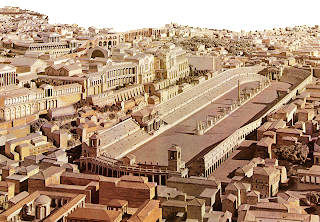Not all cities were big enough for a Circus, and they have a very poor track record with respect to surviving to the modern era. When the Empire fell on hard times the complex organizational skills that could produce teams of highly trained charioteers just vanished. And without races to watch, and to bet on, there was little point in having a Circus. Poorly adaptable to other uses, and often near the edge of town where you could rob out stones with little official notice, they just vanished.
Here is an artists reconstruction of what the biggest of them all, the Circus Maximus in Rome, once looked like:
And in a somewhat stylized mosaic from the Gallo-Roman museum in Lyon, is a contemporary view, probably representing a yet undiscovered Circus in that city:
The circus at Arles followed the basic pattern. It had an oval track wide enough for 12 chariots to race at once. It had a central "spine" or spina on which one would find lap counters and an obelisk that marked the finish line. And seating, perhaps for as many as 20,000 spectators. Today there is not much remaining to view, just this sad little bit of foundation outside the Musee de l' Arles Antique:
Sidonius mentions being there circa 461. And he was certainly well acquainted with the racing life, here is his description of a race he witnessed in the Circus of Ravenna:"There behind the barriers chafe those beasts, pressing against the fastenings, while a vapoury blast comes forth between the wooden bars and even before the race the field they have not yet entered is filled with their panting breath...never are their feet still, but restlessly they lash the hardened timber....The others are busy with hand and voice, and everywhere the sweat of drivers and flying steeds falls in drops on to the field. The hoarse roar from applauding partisans stirs the heart, and the contestants, both horse and men, are warmed by the race and chilled by fear....You sped straight past your swerving rival...."One rather remarkable feature of the Arles Circus is that it was built on swampy ground. It speaks of the confidence of Rome in its prime that this was not considered a problem. 28,000 wooden piles were driven in to support the Circus, doing such a good job of it that it remained in service for over 300 years. I found a fascinating description of this process in a rather unlikely source: Pile Driver: The Official Publication of The Pile Driving Contractors Association It is a rather sizable download with all too many advertisements for heavy equipment, but interesting in a technical sense. The wooden piles for instance allow precise dating of the project, analysis of growth rings indicates the logs for the pilings were cut in the winter of AD 148/149.
Sidonius Apollinaris, To Consentius (XXIII)
The Circus eventually fell into disrepair, the stones removed for shoring up the city walls in troubled times. But the Obelisk stayed, finally being found on its side, broken into two parts in the 17th Century. In 1675 it was hauled with difficulty to a central square and put on a new pedestal.
Recent studies suggest that it is not Egyptian in origin, but rather hails from Asia Minor. It appears to have been quarried solely as an ornamental item, and to have been placed in the Arles Circus rather late, during the reign of Constantine II (337-340). We tend to think of the later Empire as being in a state of near collapse, but things obviously were organized enough for some rather specialized commerce!
Tips for a visit. The obelisk is hard to miss. It sits smack in the middle of the Place de la Republique. The site of the Circus is a bit out of the way....you would probably not go there unless also planning a visit to the Arles Museum of Antiquity. The remains of one end of the Circus are right outside of it.
The rest of the Circus lies under modern structures including a freeway bridge over the Rhone river. On our trip we got mixed up and drove back and forth over it several times, unconsciously imitating the repeated circling of an ancient chariot driver!
More on circuses throughout the Empire




No comments:
Post a Comment